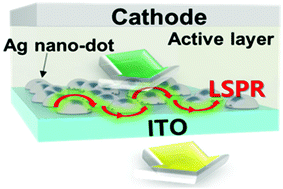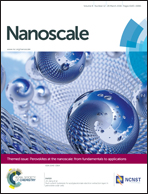The effect of localized surface plasmon resonance on the emission color change in organic light emitting diodes†
Abstract
Three primary colors, cyan, yellow, and green, are obtained from Ag nano-dot embedded organic light emitting diodes (OLEDs) by localized surface plasmon resonance (LSPR). By changing the thickness of the Ag film, the size and spacing of Ag nano-dots are controlled. The generated light from the emissive layer in the OLEDs interacts with the free electrons near the surface of the Ag nano-dots, which leads to LSPR absorption and scattering. The UV-visible absorption spectra of glass/ITO/Ag nano-dot samples show intense peaks from 430 nm to 520 nm with an increase of Ag nano-dot size. And also, the Rayleigh scattering spectra results show the plasmon resonance wavelength in the range of 470–550 nm. The effect of the LSPR of Ag nano-dots on the change of emission color in OLEDs is demonstrated using 2 dimensional finite-difference time-domain simulations. The intensity of the electro-magnetic field in the sample with 5 nm-thick Ag is low at the incident wavelength of 500 nm, but it increases with the incident wavelength. This provides evidence that the emission color change in OLEDs originates from LSPR at the Ag nano-dots. As a result, the emission peak wavelength of OLEDs shifted toward longer wavelengths, from cyan to yellow-green, with the increase of Ag nano-dot size.


 Please wait while we load your content...
Please wait while we load your content...